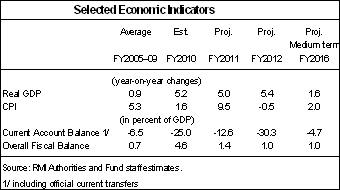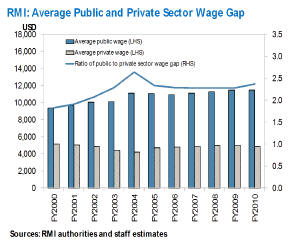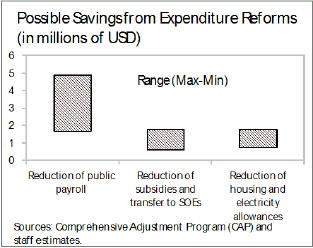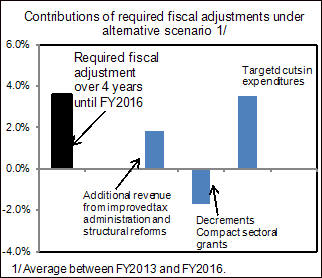Republic of Marshall Islands (RMI)—2011 Article IV Consultation Concluding Statement of the IMF Mission
October 7, 2011
Describes the preliminary findings of IMF staff at the conclusion of certain missions (official staff visits, in most cases to member countries). Missions are undertaken as part of regular (usually annual) consultations under Article IV of the IMF's Articles of Agreement, in the context of a request to use IMF resources (borrow from the IMF), as part of discussions of staff monitored programs, and as part of other staff reviews of economic developments.
This statement summarizes the mission’s preliminary views and policy recommendations based on discussions in Majuro.1 The discussions focused on policies to strengthen fiscal management, reform state-owned-enterprises (SOEs), and promote the private sector. The economic recovery is expected to continue in the near term supported by ongoing expansion of the fisheries sector and construction activities, but faces headwinds over the medium-term from the scheduled declines in foreign grants. In that context, a comprehensive package of tax reforms, targeted expenditure cuts, together with structural reforms to nourish private sector growth, are essential to secure the long-term fiscal and economic sustainability when Compact-related grants expire in FY2023.
I. Background and Outlook
1. Since the last IMF Article IV consultation in 2009, the economy has recovered strongly. Following a severe recession in FY2008–09, the economy grew by 5.2 percent in FY2010, driven by an expansion of fishery capacity and exports, a recovery of external demand, and the moderation of fuel prices.2 Inflation stabilized in FY2010 following the temporary surge of food and fuel prices in FY2008–09.
2. The recovery is likely to continue in the near term, but prospects over the medium term are overshadowed by the scheduled declines of Compact sector grants. Growth in FY2011 is estimated at about 5 percent, driven by an increase in fish output from the newly commissioned purse seiners, large inflows under the Kwajalein land use agreements (LUA) and the FAA-funded airport extension project. Growth has been concentrated only in a few sectors, while rising unemployment and financial hardship, especially in outer islands, have driven outward migration to urban atolls and the United States. In view of scheduled declines in Compact grants and the downsizing of Kwajalein military base, the mission expects growth to stay around 1½ percent over the medium term, with the growth in fisheries sector partly offset by the decline in Compact sector grants (about $½ million per annum before adjusting for inflation).
3. Risks to the outlook are on the downside. The economy could face stiffer headwinds if the current global slowdown proves severe and prolonged. Weak financial positions in the energy company could disrupt fuel and electricity supplies, hinder economic activities, and add pressures to the public finance. On the upside, further investment in commercial fisheries could generate positive spillovers to the rest of the economy. The pending U.S. funded satellite project in Kwajalein could also create new jobs, offsetting the adverse impact of the downsizing of the Kwajalein military base. Longer-term risks include continued outward migration and shore erosion on local atolls from climate change.
4. Along with the economic recovery, the overall fiscal balance improved in FY2010 but mostly as a result of unspent earmarked appropriations. A modest surplus was recorded ($0.4 million) in the general fund for discretionary uses in FY2010. The overall surplus in FY2011 is estimated to be modest, with a 5.5 percent across-the-board cut of current expenditures partly offset by increased subsidies and transfers to public enterprises to cover operating losses.
5. The deterioration in the current account is expected to continue until FY2013, mainly driven by temporary factors. The widening of the current account deficit reflects increased imports under the Kwajalein LUA, new investment in the fisheries sector and the airport extension project that are financed mainly through foreign direct investment and capital grants. Tourism receipts declined after the charter-flight discontinued but have limited impact on the external balance given their small share of export receipts. In the absence of these temporary factors beyond FY2013, the current account deficit is expected to decline to around 5 percent over the medium term. Though external debt is relatively high at about $117 million (about two-thirds of GDP) as of end-FY2011, it is mainly on concessional terms and is expected to decline.
II. Policies to Achieve Sustainable Growth
A. Fiscal Policy
6. Under current policies, the build up in government assets through the Trust Fund is projected to fall short of replacing Compact-related grants expiring in FY2023. Moreover, the global financial crisis has made the challenge of achieving long-term budgetary self-reliance even more difficult. The market value of the Compact Trust Fund (CTF) stood at about $142 million as of end-June 2011, but the value is likely to have declined following the sharp fall in global equities since then. Under the assumption that all Compact-related grants expire in FY2023, the projected income from the CTF would fall short of replacing these grants by as much as $14.9 million (about 8½ percent of GDP) in FY2023 (see Appendix).3 Even under a more optimistic assumption that non-Compact sector grants would be extended beyond FY2023, the shortfall—about $4.1 million—is still sizeable and warrant prompt actions to ensure sustainability.
7. Steadily increasing fiscal surpluses to about 5 percent of GDP by FY2016 would help achieve long-term sustainability. This will involve gradually raising the fiscal surplus by about 1 percent per year for the next four years to 5 percent of GDP in FY2016, and then maintaining the surplus at that level until FY2023. The recent transfer of $1.1 million to the CTF during FY2011 and the plan to continue such transfer in the FY2012 budget are welcome steps. In view of the substantial adjustment required, higher-than expected revenues from the fisheries sector should be used to accelerate transfers to the CTF as a buffer against cyclical shocks.
8. To achieve the required fiscal adjustment, targeted cuts in expenditures are also needed. The mission commends the cumulative across-the-board cuts of over 10 percent in current expenditures over the past two years and encourages a more targeted approach going forward to ensure quality public services are not compromised, such as the social safety net for the poor. Targeted cuts in areas proposed by the Comprehensive Adjustment Program (CAP) group could achieve a saving of $7–8 million over the medium term (see charts).
- Containing public sector payroll. Though the annual average rise in public wages during FY2005-11 was modest at 1.4 percent, the average public wages remain around 2½ times higher than those in the private sector. The mission notes the government’s efforts in identifying over-staffing and excess pay, and would recommend reducing public sector payroll further by eliminating most vacant positions beginning in FY2012, which could save as much as $1 million according to the CAP recommendations.
- Limiting subsidies to state-owned enterprises. Several SOEs continue to be a large and recurring drain on the budget. Budget support through subsidies, net cash advances, and capital injections amounted to about $14.2 million per year (nearly 15 percent of overall budget) on average over FY2007–10, with the Marshall Energy Company (MEC) and Air Marshall Islands (AMI) being the largest recipients. The mission recommends limiting subsidies to the SOEs and expediting the reform under the assistance of the Asian Development Bank (AsDB). The Cabinet has approved a set of good practice principles on several SOEs to address key issues on governance, disclosure, corporate planning and pricing issues. A comprehensive recovery plan for the MEC was separately approved but gaps remain in addressing the recurring cash flow problems and widening operating losses, which pose significant fiscal risks (see paragraph 14).
- Reducing allowances. The government provides allowances (such as housing and electricity) to public officials at a significant fiscal cost (about $2 million in FY2009). The mission welcomes the government’s plan to reduce these benefits in FY2012.
9. In parallel to these targeted expenditure cuts, swift legislative approval on revenue reform is imperative to put the public finance on a sustainable path. Though the authorities expect the comprehensive tax reform to be revenue-neutral, broadening tax base and improved tax administration could generate additional revenue as well as support a more pro-growth business environment. The mission urges the authorities to overcome remaining public concerns regarding new tax rates, and to bring forward the legislative process, so as to start implementing the tax reforms within FY2012. Systematic consultation and public outreach, including community-based forums, would help mobilize public support. Further efforts to strengthen the tax administration, particularly on identifying unaccounted import duties, would lead to fairer tax system and additional revenue.
10. A sound public financial management (PFM) would improve the efficiency of spending. In the face of scheduled declines in Compact grants, the mission notes the authorities’ efforts in formulating a Medium-Term Budget and Investment Framework (MTBIF) and Medium-Term Expenditure Framework (MTEF) as a budgeting tool to complement the decrement management plan. To enhance the efficiency of spending, the mission would recommend:
- Accelerating efforts to enhance the public finance management through the Public Expenditure and Financial Accountability (PEFA), and modernization of the Financial Management Act, which will streamline the procurement procedures.
- Bringing the MTBIF and MTEF into the annual budget preparation process. Once a sound framework is put in place, it could be integrated with the national development plans to contribute to long-term sustainability.
11. While financial and compliance audits are adequately undertaken, broadening the capacity for performance audits is needed. The government would benefit from enhancing the capacity of the Office of Auditor General in areas related to investigation and performance audits. In that regard, the mission supports granting the Auditor General the authority to prosecute public sector frauds through delegation by the Attorney General. The mission sees room for further increasing of resources to the Office, possibly through the capacity-building grants under the amended Compact.
12. Social security system continues to constitute a sizeable contingent liability. The Marshall Islands Social Security Administration (MISSA) has partially recovered long-time arrears from local governments, but still faces about $163 million of unfunded liabilities (more than 100 percent of GDP). Beginning FY2010, the MISSA had to liquidate trust fund assets to make up for the shortfall in contributions. In light of unsustainable financial situations and investment losses during the global downturn, the authorities are considering a transition to a defined contribution scheme. As the transition would take time to be put in place, the mission also encourages the authorities to take interim measures to safeguard the value of the Social Security Fund, including through revising contribution rates and benefit structure, and increasing the retirement age.
B. Private Sector Development
13. A vibrant private sector is a prerequisite for sustainable economic growth. Many private sector activities depend largely on government contracts and services provided by inefficient SOEs, which are likely to face challenges in the midst of fiscal adjustment and declining Compact grants. The government’s role in supporting private sector growth should be to provide an enabling environment. Key obstacles include limited access to commercial lending, difficulties in securing land uses, aging infrastructure, and the large gap between public and private sector wages. Enhancing private sector growth through structural reforms would complement fiscal adjustment.
14. Comprehensive reforms of SOEs are needed to raise their efficiency. The SOEs are economically significant with total assets of $116 million as of end-FY2008 (about 76 percent of GDP), but their financial performance has been lackluster. Many SOEs have social service obligations, which are often not clearly defined, further complicate resource planning and lead to weak management and underinvestment. These obligations also impair their ability to effectively provide services and support growth. In areas where SOEs provide purely commercial services, operation should be divested or contracted out (for example, government ownership in hotels and AMI). A new SOE policy is under preparation, which will form a basis for the forthcoming SOE Reform Act. The mission urges the authorities to take full ownership of the reform and swiftly approve the policy with the assistance from AsDB.
15. Recent expansion of commercial fishery activities through foreign investment and intergovernmental agency could help spur private sector development. Commercial fisheries, a key source of employment and growth in recent years, have increasingly diversified operations in harvesting, processing, transshipment, and exports. The authorities could take advantage of the fishery investment to spur private activities and strengthen the investment environment, including vessel support services, and retail and wholesale areas. In this context, the Parties to the Nauru Agreement (PNA), in which RMI participates, aims to foster the sustainability of fishery activities through enforcing and exchanging vessel days, which will contribute to long-term growth.
C. Financial Sector Stability and Development4
16. The banking system in general remains profitable. The banking sector is primarily financed by deposits, with about two-thirds of deposits allocated for lending. Growth in commercial lending has been constrained by the lack of collateral, high interest rates, and limited investment opportunities. Although banks now enjoy high profit margins (around 5-8 percent), these could decline if credit risks were to rise in the event of a slowdown as many households are heavily indebted with short-term consumer loans.
17. Strengthening the regulatory framework would contribute to stability in the financial sector. The Banking Commission currently has limited authority and autonomy to undertake appropriate bank supervision under the Banking Act as its actions could be appealed to and reverted by the Cabinet. The mission supports the Banking Commission’s efforts to revise the Banking Act to strengthen bank supervision and AML/CFT in line with PFTAC assistance. The mission also supports broadening the Banking Commission’s oversight to include the Marshall Islands Development Bank (MIDB) and other nonbank financial institutions that engage in private lending activities.
18. Financial policies should aim to facilitate credit intermediation and support long-term growth. The lack of commercial credit has held back new start-ups and viable business opportunities. The act on secured transactions for moveable property has enabled access to commercial credit at reduced cost. Refocusing the MIDB towards commercial and mortgage lending, rather than consumer loans, and further streamlining the land registration process would expand businesses’ access to much needed capital.
D. Exchange Rate and External Sustainability
19. The risks to external stability are limited. The current account deficits are expected to remain wide until FY2013, mainly related to investment in fisheries and airport extension project that are financed through foreign direct investments and capital grants. Compact-related financial flows dominate external balances and will continue to provide a stable source of funding over the next decade. External debt is expected to decline, as debt repayments rise in the coming years. The use of the U.S. dollar as the official currency is appropriate given the small size of the economy and its close financial linkages with the United States.
20. The RMI’s exchange rate appears to be in line with the medium-term fundamentals of the economy. The real appreciation in FY2008-09 was largely reversed since second half of 2009 as domestic prices stabilized. More fundamentally, exports have continued to expand, in contrast to some other pacific islands countries. In the long run, the expiration of the Compact could lead to an erosion of foreign assets undermining external stability unless the authorities undertake needed fiscal adjustments and structural reforms.
E. Other Issues
21. Improving the reliability, coverage, and timeliness of economic statistics would better guide policies. The mission notes ongoing efforts by the Economic Policy, Planning and Statistics Office (EPPSO) to improve data collection. The mission also encourages the policy planning to incorporate the latest national census data conducted in 2011 in assessing demographic and socio-economic developments.
The mission would like to thank the authorities for their hospitality and thank members of the government, political leaders, and private sector representatives for fruitful discussions.
| Table 1. Marshall Islands: Medium-term Scenario, FY2007–16 1/ | |||||||||||||
| 2007 | 2008 | 2009 | 2010 | 2011 | 2012 | 2013 | 2014 | 2015 | 2016 | ||||
|
Real sector |
Est. | Projections | |||||||||||
|
Real GDP (percent change) |
3.0 | -1.9 | -1.3 | 5.2 | 5.0 | 5.4 | 2.6 | 0.6 | 1.4 | 1.6 | |||
|
Consumer prices (percent change) |
2.6 | 14.7 | 0.5 | 1.6 | 9.5 | -0.5 | 1.5 | 1.7 | 1.9 | 2.0 | |||
|
Central government finance (in percent of GDP) 2/ |
|||||||||||||
|
Revenue and grants |
72.3 | 70.2 | 69.2 | 67.0 | 63.6 | 62.9 | 60.9 | 59.1 | 58.5 | 58.0 | |||
|
Total domestic revenue |
25.8 | 25.6 | 25.0 | 24.7 | 24.1 | 22.9 | 22.8 | 23.0 | 23.1 | 23.1 | |||
|
Grants |
46.5 | 44.5 | 44.3 | 42.3 | 39.5 | 40.0 | 38.2 | 36.1 | 35.4 | 34.9 | |||
|
Expenditure |
72.0 | 66.4 | 67.8 | 62.4 | 62.1 | 61.9 | 60.4 | 58.4 | 57.7 | 56.9 | |||
|
Current 3/ |
54.9 | 54.3 | 56.7 | 51.7 | 51.6 | 49.0 | 48.4 | 48.6 | 48.1 | 47.6 | |||
|
Capital |
17.2 | 12.1 | 11.2 | 10.7 | 10.5 | 12.9 | 12.0 | 9.8 | 9.6 | 9.3 | |||
|
Overall balance |
0.2 | 3.7 | 1.4 | 4.6 | 1.4 | 1.0 | 0.5 | 0.7 | 0.8 | 1.0 | |||
|
Memorandum item: including the new ADB loans to MEC |
|||||||||||||
|
Overall balance (in percent of GDP) 4/ |
0.2 | 3.7 | 1.4 | 4.6 | -4.1 | 1.0 | -2.1 | 0.7 | 0.8 | 1.0 | |||
|
Financing: gross borrowing (in USD million) |
0.1 | 0.0 | 0.0 | 0.0 | 9.5 | 0.0 | 5.0 | 0.0 | 0.0 | 0.0 | |||
|
Compact Trust Fund (in millions of US$; end of period) |
85.7 | 75.7 | 90.9 | 112.8 | 142.8 | 165.2 | 190.7 | 218.3 | 248.2 | 290.5 | |||
|
Balance of payments (in millions of US$) |
|||||||||||||
|
Trade balance |
-69.6 | -69.8 | -73.3 | -93.3 | -73.7 | -101.8 | -81.3 | -57.0 | -59.2 | -57.7 | |||
|
Net services |
-39.0 | -39.5 | -54.0 | -42.8 | -45.6 | -48.1 | -48.1 | -45.7 | -46.3 | -46.4 | |||
|
Net income |
43.1 | 43.2 | 40.8 | 34.5 | 41.7 | 30.2 | 28.7 | 31.9 | 33.1 | 33.3 | |||
|
Private and official transfers |
62.0 | 62.2 | 60.2 | 60.9 | 55.8 | 63.7 | 62.1 | 60.2 | 60.7 | 61.4 | |||
|
Current account including official current transfers 5/ |
-3.5 | -3.9 | -26.4 | -40.7 | -21.8 | -55.9 | -38.6 | -10.6 | -11.6 | -9.4 | |||
|
(In percent of GDP) |
-2.4 | -2.6 | -17.4 | -25.0 | -12.6 | -30.3 | -20.2 | -5.5 | -5.9 | -4.7 | |||
|
Current account excluding budget grants 5/ |
-57.3 | -61.2 | -80.8 | -96.9 | -77.0 | -119.0 | -100.0 | -70.2 | -71.7 | -70.1 | |||
|
(In percent of GDP) |
-38.3 | -40.1 | -53.3 | -59.4 | -44.3 | -64.6 | -52.5 | -36.3 | -36.4 | -34.8 | |||
|
External debt (in millions of US$; end of period 6/ |
99.1 | 94.6 | 106.8 | 113.4 | 117.0 | 110.5 | 108.7 | 102.1 | 96.2 | 90.0 | |||
|
(In percent of GDP) |
66.2 | 62.0 | 70.4 | 69.6 | 67.4 | 60.0 | 57.0 | 52.9 | 48.8 | 44.7 | |||
|
External debt service (in millions of US$) |
16.8 | 7.5 | 7.8 | 9.7 | 9.7 | 10.1 | 10.0 | 9.1 | 8.2 | 8.3 | |||
|
(In percent of exports of goods and services) |
59.4 | 24.7 | 24.8 | 22.2 | 18.4 | 17.1 | 15.2 | 13.4 | 11.9 | 11.5 | |||
|
Sources: Data provided by the RMI authorities; and Fund staff estimated 1/ Fiscal year ending September 30. 2/ The central government finance numbers do not include the first tranche disbursement of $9.5 million in early FY2011 and a projected second tranche disbursement of the new ADB loan to the Marshall Energy Company 3/ In FY2008, a cash advance of US$6.75 million to Marshall Energy Company is recorded as subsidy to public enterprises. The advance is reimbursed by offsetting government electricity payments (under expenditure on goods and services) that spread across FY2008–FY2011. 4/ The payments by the government to MEC will be recorded as subsidy to public enterprises of $8.5 million and increase of gross borrowing of $9.5 million in FY2011. The second tranche 5/ Budget grants are official current transfers, which exclude capital transfers and Trust Fund contributions. 6/ Government and government-guaranteed debt only. | |||||||||||||
| Marshall Islands Compact Trust Fund (CTF) Scenarios | |||
| Baseline Scenario | Alternative Policy Scenario 1/ | ||
| (In millions of U.S. Dollars) | |||
|
Compact Trust Fund in FY2023 (including cumulative savings) |
590.2 | 710.1 | |
|
Earnings based on Trust Fund assets in FY2024 |
35.4 | 42.6 | |
|
Earnings available for withdrawal 2/ |
24.2 | 29.1 | |
|
Compact grants in 2023 (in/ supp. educational) |
42.6 | 42.6 | |
|
Compact grants net of fiscal surplus |
39.1 | 29.1 | |
|
Surplus (+) or Shortfall (-) 3/ |
-14.9 | 0.0 | |
|
Medium-term fiscal balance by FY2015 |
|||
|
in percent of GDP |
1.4 | 5.0 | |
|
Source: IMF staff calculations. 1/ In the alternative policy scenario, the government would gradually shift public finances into surplus (by about one percent of GDP each year) over the medium term through tax reforms and targeted expenditure cuts. In parallel, structural reforms would be implemented to boost real growth. 2/ Earnings withdrawn such that the real value of the Trust Fund remains the same. 3/ Calculated as earnings available for withdrawal minus Compact grants in 2023 net of fiscal surplus. | |||
| ||||||||||||||||||||||||||||||||||||||||||||||||||||||||||||||||||||||||||||||||||||||||||||||||||||||||||||||||||||||||||||||||||||||||||||||||||||||||||||||||||||||||||||||||||||||||||||||||||||||||||||||||||||||||||||||||||||||||||||||||||||||||||||||||||||||||||||||||||||||||||||||||||||||||||||||||||||||||||||||||||||||||||||||||||||||||||||||||||||||||||||||||||||||||||||||||||||||||||||||||||||||||||||||||||||||||||||||||||||||||||||||||||||||||||||||||||||||||||||||||||||||||||||||||||||||||||||||||||||||||||||||||||||||||||||
IMF EXTERNAL RELATIONS DEPARTMENT
| Public Affairs | Media Relations | |||
|---|---|---|---|---|
| E-mail: | publicaffairs@imf.org | E-mail: | media@imf.org | |
| Fax: | 202-623-6220 | Phone: | 202-623-7100 | |











